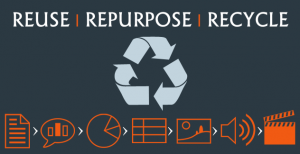This is the second in a series of blog posts addressing key steps in the instructional design process for online learning courses. In the first post (Instructional Design for eLearning: Discovering good online learning content), I describe factors to consider when searching the internet for eLearning resources that can be reused and repurposed.
 Instructional Design for eLearning (Step 2): Reusing and Repurposing Online Learning Content
Instructional Design for eLearning (Step 2): Reusing and Repurposing Online Learning Content
Once you have completed the first step of finding learning content that you can reuse or repurpose, the next step is to make that content understandable and engaging to help your students work with and learn from it.
There are many different ways to repurpose learning content, and what works best may depend on a number of factors, including:
The Discipline
What works well in history may not in mathematics. This is where the teacher’s pedagogical experience is crucial, in terms of knowing what works best in getting across to students particular areas of content or approaches to learning.
The Content
Some content may already be understandable and engaging. In this case, you may be able to reuse learning content without doing much of anything to it.
In other cases, the content may be good, but the language may be difficult or the assumptions about previous knowledge may not be appropriate.
The Learner
Assuming you are creating lessons for your own students, you can take advantage of your knowledge of the academic backgrounds, interests, and capabilities of your students to provide the right amount of scaffolding to support learning.
These considerations will help guide you in deciding how to shape, revise or repurpose learning content to best meet the needs of your students.
Other factors that will impact the degree to which you can reuse learning content include:
Time—sometimes you can make quick tweaks, and sometimes the work required may be more extensive
Interest/Commitment—these are often affected by the content author’s comfort level and experience with technology generally and with content authoring specifically
Support—the availability of local peers or experts who can share experience or offer help can be extremely valuable in terms of gaining technical support and gaining insight into what’s possible
Resource Availability—how much effort you spend may depend on how many other learning resources are already available for that unit of learning.
Reusability—the extent to which the content you develop represents a uniquely informative asset that can continue to be used for some time, or for more than one purpose
With the enormous resources available today, developing a high-quality instructional design for online learning for your students or program doesn’t have to be arduous.
Reuse learning content and repurpose existing material to develop high quality, pedagogically effective, learning materials that meet the unique needs of your learners.
In the third post (Step 3: Making Content Pedagogically Effective), we consider how to organize the content to work digitally.
About Robert Godwin-Jones, Ph.D.
Dr. Godwin-Jones is considered a pioneer in instructional design for eLearning and leading authority on the instructional design process for online learning courses. He was a founding partner of SoftChalk and formerly responsible for product research and design. Prior to SoftChalk, Robert was a founding partner of madDuck Technologies where he was a co-developer of the Web Course in a Box Learning Management System.
He is the former Director of the Instructional Development Center at Virginia Commonwealth University and is currently a faculty member in their School of World Studies. His principal areas of research are in applied linguistics and international studies. He writes a regular column on emerging technologies for the peer-reviewed journal Language Learning & Technology (llt.msu.edu) and blogs on intercultural communication at http://acrossculturesweb.com/wp/.

Leave a Reply